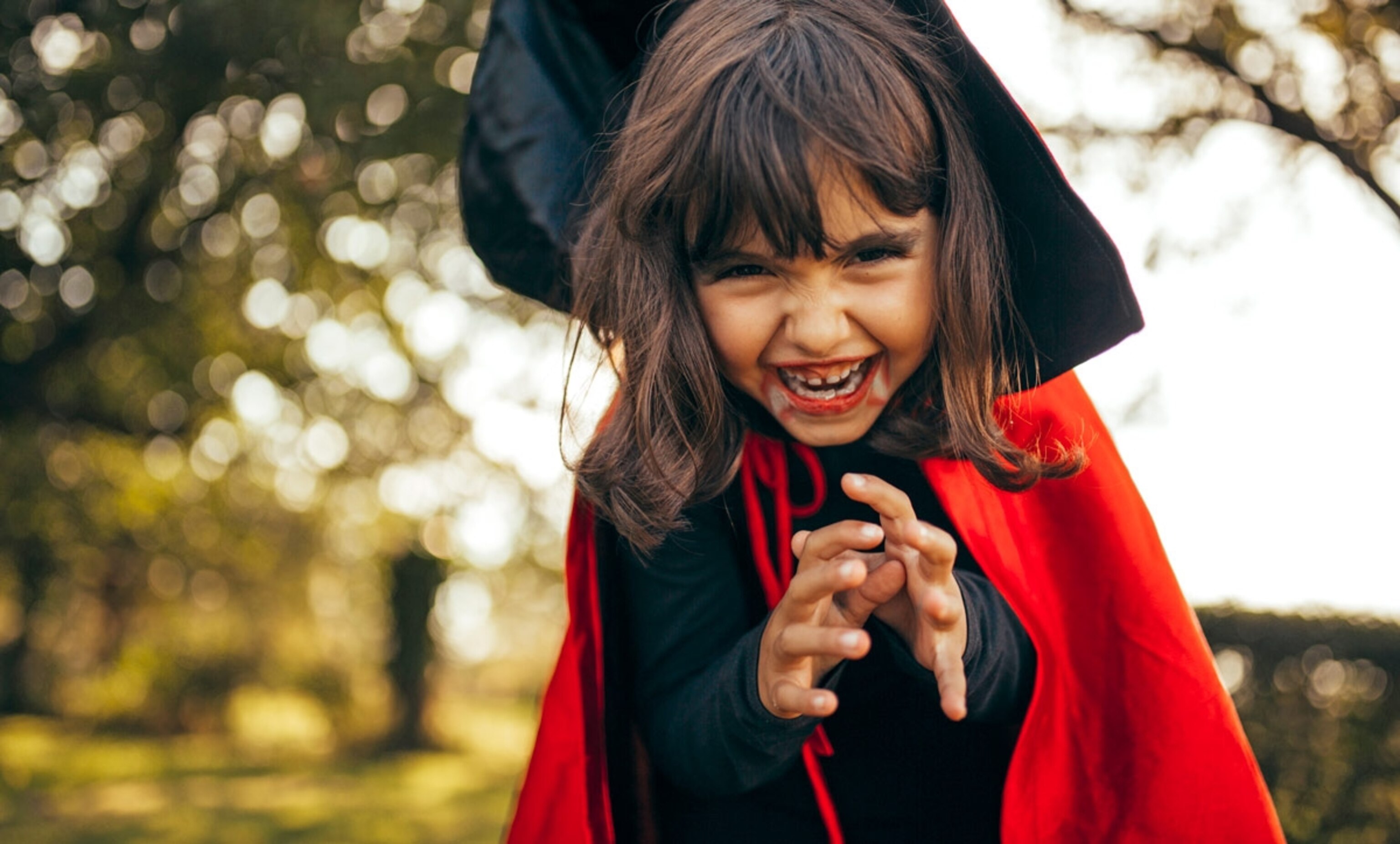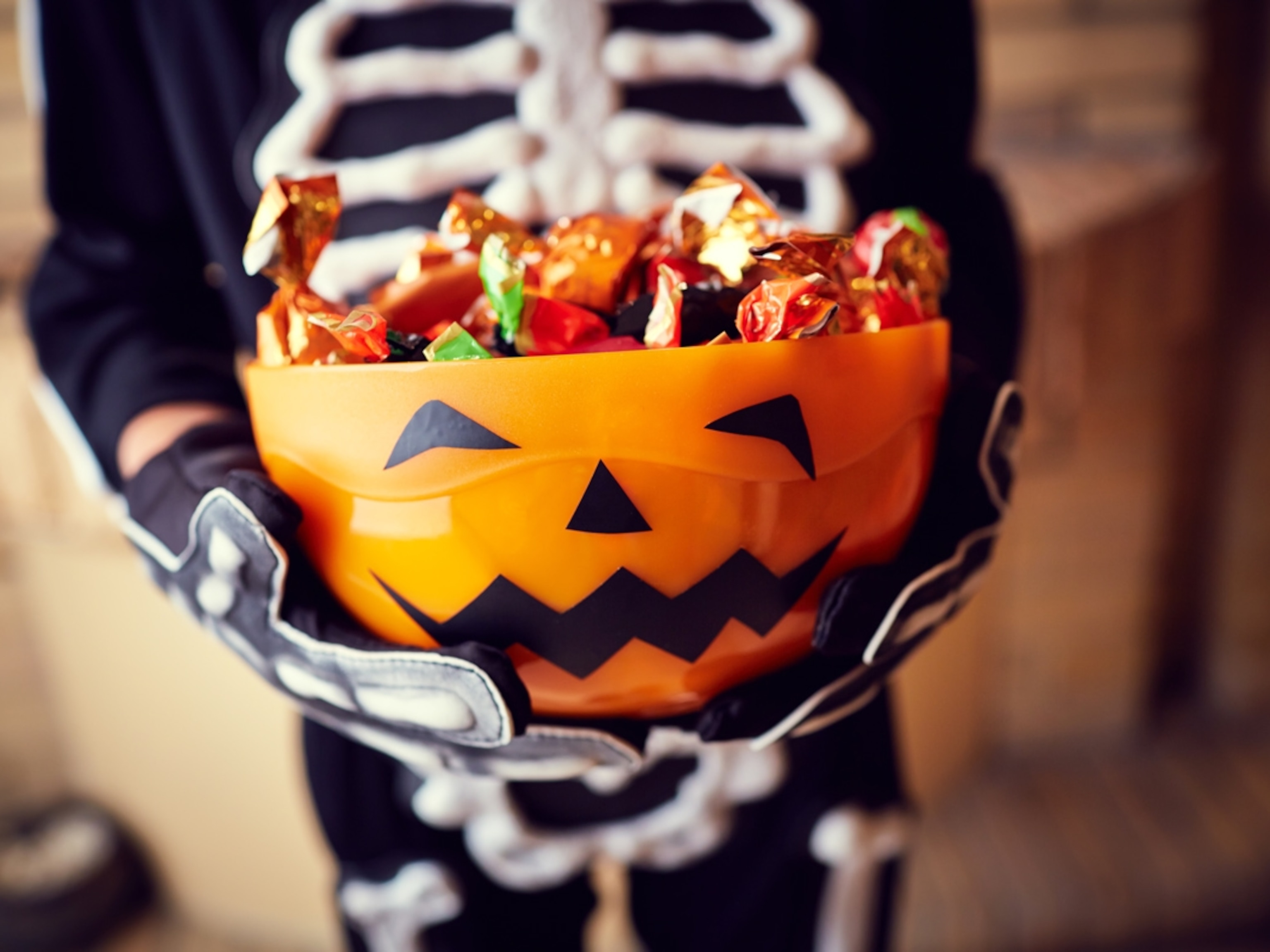
The spooky-but-true history behind your kid’s Halloween costume
Take a look at the folklore that inspired today’s trick-or-treat getups. Plus: 5 DIY costumes.
Kids might think they know everything about vampires and witches thanks to movies and TV—but their favorite Halloween costume is likely rooted in much older global history. And learning a little more about the culture behind the character can be an added treat this Halloween.
“All of these monsters have very complicated and fascinating histories about who we are as humans,” says monster expert Emily Zarka, host of PBS’s Monstrum.
Halloween itself is rooted in the ancient pagan Celtic festival of Samhain, when folks lit bonfires and likely wore animal skins to confuse the spirits thought to be walking the Earth that night. People also were thought to have left food and drink outside as an offering to these supernatural beings. The Celts’ descendants were believed to have gone from house to house performing songs or dances in exchange for food and drink, says Natalie Underberg-Goode professor of digital media and folklore at the University of Central Florida.
By the seventh century, Christian leaders co-opted these pagan rituals and named November 1 All Saints’ Day, or All Hallows’ Day. But Samhain traditions were still celebrated the night before: All Hallows’ Eve.
Eventually, immigrants from the British Isles—particularly Ireland, Scotland, and Wales—brought these traditions to the United States; the first official Halloween celebration was probably in 1920 in Anoka, Wisconsin. And though the modern Halloween costumes that most kids know today—vampires, werewolves, zombies, witches—come primarily from movies, “each of them has a connection to folklore,” Underberg-Goode says. Here are some traditional Halloween ghouls your kids might be dressing up as, and the spooky-but-true history behind them.
The costume: Vampire
The history: Underberg-Goode says the vampyre—the creature scholars believe vampires are based on—first shows up in 18th century Slavic literature, but the folklore of a possessed peasant goes back even further than that. “Some of the characteristics of Slavic vampires are known to us today,” she says. “Biting people to infect them, shape-shifting into bats or wolves, and how they can be killed.”
One researcher thinks that the idea of a vampire was born out of fears around diseases people couldn’t yet explain, like rabies, which could cause infected people to be aggressive and even bite, as well as become sensitive to stimuli like light. And the use of garlic as a vampire repellent might be because the vegetable was sometimes used as medicine then.
But your child’s costume is likely inspired by the 1931 movie Dracula, an interpretation of Bram Stoker’s 1897 book of the same name. Stoker’s Count Dracula was likely based on 15th-century tales of Vlad the Impaler, a Transylvanian-born warlord also known as Draculea. (Translation: “Devil” in Romanian.) The author gave his vampire many traits from Slavic folklore—including the ability to shift into a bat—but the movie introduced the idea of a tuxedo-wearing bloodsucker with slicked-back hair.
Make the costume: Kids can dress up as a vampire’s alter ego with this DIY bat costume.
The costume: Zombie
The history: Turns out just about every culture has a tale of corpses coming back from the dead. “Going back thousands and thousands of years, every culture that I've identified that buries their dead also has some kind of reanimated corpse monster associated with it,” Zarka says.
For instance, Nordic and Scandinavian folklore have the dragur, a reanimated corpse that looks a lot like a Game of Thrones White Walker and wreaks havoc on the living; Chinese stories tell of the jiangshi (“stiff corpse”) that absorbs the life force of others.
But the term “zombie” has its roots in Western Africa, likely coming from the Kikongo terms nazambi, meaning god, and zumbi, something that holds supernatural powers. Africans kept this language alive when they were abducted, transported, and enslaved in Haiti beginning in the 16th century.
To many enslaved Haitians practicing the traditional Vodou religion, death would connect them to their African homeland. But they also believed that if they took their own life, a sorcerer called a bokor could steal part of their soul, which would force them to continue in enslavement even after death. It was a belief encouraged by plantation owners to discourage the workers from escaping the only way they knew how.
“These people are already under the horrific conditions of slavery,” Zarka says of enslaved West Africans. “They're being treated terribly, they're dying, they are not in control of their own bodies. So what would potentially be even worse than that? Being enslaved or controlled after death.”
Most Haitians didn’t fear zombies—but they did fear becoming one. Those beliefs followed them to the United States during and after the Haitian revolution (1791-1804), when many plantation owners fled with the West Africans. But it was only after the 1968 movie Night of the Living Dead when zombies gained a fan following as dangerous, terrifying monsters.
Make the costume: You don’t want to be bitten by a zombie—or a spider. Check out this DIY eight-legged costume. (But spiders do keep insect numbers under control—so leave them alone!)
The costume: Werewolf
The history: Many cultures have shape-shifters that turn into animals, but the wolf might have especially taken hold because of our ancient bond with these canines: They evolved into our domesticated companions some 10,0000 to 30,000 years ago, and we also connect emotionally with their similar family units.
Zarka says the oldest reference to a person turning into a wolf appears in the Mesopotamian poem Epic of Gilgamesh from the second century B.C. But the idea didn’t become popular legend until the 15th century, when the Catholic Church blamed any kind of deviant behavior—from violent acts to anti-faith behavior—on dark magic or the Devil turning people into creatures. During the 15th century, Zarka says that just about any kind of excessive hair growth (on the backs of hands, for example) or “unusual” behavior (a habit of collecting herbs in the woods late at night) could be seen as possible werewolf traits—which could lead to a trial and execution.
And the idea that werewolves turn at the full moon? Zarka says the legend might be tied to French folklore but is more likely to have been popularized in film.
Make the costume: Wolves aren’t the only animals attached to shape-shifting legends. Check out this costume for your kid’s “mane” Halloween event.
The costume: Witch
The history: The link between witches and “women’s work”—cooking cauldrons and brooms, for instance—are hard to miss. “Often, those women might be older, they might be widowed, or they might be in nontraditional social roles like midwives and healers,” Zarka says. These were often independent women living in a patriarchal system, and the risk of an accusation of witchcraft might have been enough to keep them from revolting.
The witch’s companion cat also has a long association with the Devil. “While it’s unclear if black cats had a previously well-established history as bad luck or demonic figures,” Zarka says, “when Pope Gregory IX declared cats ‘the devil’s servants’ in 1233, their fate was seemingly sealed.”
Make the costume: Cast a spell on the traditional witch outfit by turning it into this cat-in-a-tree getup.
The costume: Mermaid
The history: As early as 1000 B.C., a Syrian legend tells of a goddess who was bottom-part fish and top-part human. Christopher Columbus even claimed to see similar creatures in 1493 while sailing through the Caribbean, though he noted they weren’t as pretty as he imagined. (Most historians think he actually spotted some manatees.)
Like many monsters, the mermaid likely developed out of humans’ limited understanding of treacherous things they couldn’t explain. The idea of dangerous, beautiful women hanging out below the water might have been easier to blame than some of the real-life natural phenomena sailors simply couldn’t explain at the time.
“Mermaids have connections to sirens and harpies, which were largely about actual dangers that existed for sailors and seafarers,” Zarka says. Stemming from Greek mythology, both were half-woman, half-animal creatures: With their beautiful songs, sirens hypnotized sailors into dangerous situations; birdlike harpies were sent by Zeus to punish people. But cultures from Africa and Asia also have mermaid tales, crediting them for everything from weather mishaps to ship rescues.
Make the costume: The mermaid legend struck fear into many sailors—just like this real ocean creature does today. (But don’t be too scared—sharks are important habitat protectors that keep the ocean healthy.)




